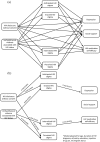Exploring pathways from violence and HIV disclosure without consent to depression, social support, and HIV medication self-efficacy among women living with HIV in Metro Vancouver, Canada
- PMID: 32010448
- PMCID: PMC6971967
- DOI: 10.1177/2055102919897384
Exploring pathways from violence and HIV disclosure without consent to depression, social support, and HIV medication self-efficacy among women living with HIV in Metro Vancouver, Canada
Abstract
We used path analysis to investigate complex pathways from HIV status disclosure without consent, physical/verbal violence and depression, social support, and HIV medication self-efficacy through mediators of HIV stigma among women living with HIV in Canada. In the final model, internalized stigma fully mediated the relationship between physical/verbal violence and reduced medication self-efficacy. Enacted stigma fully mediated the relationship between HIV status disclosure without consent and depression. Internalized stigma (β = 0.252; p < 0.001) had a significant negative direct effect on medication self-efficacy. Enacted stigma had a significant direct effect on depression (β = 0.162; p = 0.037). Findings will help improve services and interventions to promote quality of life and well-being of women living with HIV.
Keywords: HIV; adherence; self-efficacy; social support; stigma; women’s health.
© The Author(s) 2020.
Conflict of interest statement
Declaration of Conflicting Interests: The author(s) declared no potential conflicts of interest with respect to the research, authorship, and/or publication of this article.
Figures
Similar articles
-
Prevalence and Correlates of HIV Stigma Among Women Living with HIV in Metro Vancouver, Canada.AIDS Behav. 2021 Jun;25(6):1688-1698. doi: 10.1007/s10461-020-03084-w. Epub 2021 Jan 2. AIDS Behav. 2021. PMID: 33389325 Free PMC article.
-
HIV disclosure without consent linked to increased violence against women living with HIV in a Canadian setting.AIDS Care. 2024 Jan;36(1):98-106. doi: 10.1080/09540121.2023.2209304. Epub 2023 May 22. AIDS Care. 2024. PMID: 37217168 Free PMC article.
-
Discrimination, Medical Distrust, Stigma, Depressive Symptoms, Antiretroviral Medication Adherence, Engagement in Care, and Quality of Life Among Women Living With HIV in North Carolina: A Mediated Structural Equation Model.J Acquir Immune Defic Syndr. 2019 Jul 1;81(3):328-335. doi: 10.1097/QAI.0000000000002033. J Acquir Immune Defic Syndr. 2019. PMID: 30893124 Free PMC article.
-
Prevalence and Correlates of HIV Disclosure Without Consent Among Women Living With HIV in Metro Vancouver, Canada.AIDS Patient Care STDS. 2023 Jul;37(7):351-360. doi: 10.1089/apc.2023.0018. AIDS Patient Care STDS. 2023. PMID: 37432310 Free PMC article.
-
Positive, Open, Proud: an adapted disclosure-based intervention to reduce HIV stigma.Front Glob Womens Health. 2024 Nov 27;5:1469465. doi: 10.3389/fgwh.2024.1469465. eCollection 2024. Front Glob Womens Health. 2024. PMID: 39664652 Free PMC article. Review.
Cited by
-
Resisting and disrupting HIV-related stigma: a photovoice study.BMC Public Health. 2023 Oct 21;23(1):2062. doi: 10.1186/s12889-023-16741-1. BMC Public Health. 2023. PMID: 37864144 Free PMC article.
-
Stigma trajectories, disclosure, access to care, and peer-based supports among African, Caribbean, and Black im/migrant women living with HIV in Canada: findings from a cohort of women living with HIV in Metro Vancouver, Canada.BMC Public Health. 2024 Nov 13;24(1):3148. doi: 10.1186/s12889-024-20439-3. BMC Public Health. 2024. PMID: 39538193 Free PMC article.
-
Impact of Canadian human immunodeficiency virus non-disclosure case law on experiences of violence from sexual partners among women living with human immunodeficiency virus in Canada: Implications for sexual rights.Womens Health (Lond). 2022 Jan-Dec;18:17455065221075914. doi: 10.1177/17455065221075914. Womens Health (Lond). 2022. PMID: 35168410 Free PMC article.
-
Brief Report: Social Factors Associated With Trajectories of HIV-Related Stigma and Everyday Discrimination Among Women Living With HIV in Vancouver, Canada: Longitudinal Cohort Findings.J Acquir Immune Defic Syndr. 2023 Nov 1;94(3):190-195. doi: 10.1097/QAI.0000000000003247. J Acquir Immune Defic Syndr. 2023. PMID: 37850977 Free PMC article.
-
Prevalence and correlates of having sexual and reproductive health priorities met by HIV providers among women living with HIV in a Canadian setting.Sex Reprod Healthc. 2021 Dec;30:100666. doi: 10.1016/j.srhc.2021.100666. Epub 2021 Sep 6. Sex Reprod Healthc. 2021. PMID: 34563858 Free PMC article.
References
-
- A Treatment Improvement Protocol: Trauma-Informed Care in Behavioral Health Services (2014) Available at: https://store.samhsa.gov/shin/content//SMA14-4816/SMA14-4816.pdf - PubMed
-
- Barreto DFL. (2017) The impact of structural inequities and interpersonal violence on food security and HIV care among women living with and affected by HIV in a Canadian setting. MSc Thesis, The University of British Columbia, Vancouver, BC, Canada.
-
- Benoit AC, Cotnam J, Raboud J, et al. (2016) Experiences of chronic stress and mental health concerns among urban Indigenous women. Archives of Women’s Mental Health 19(5): 809–823. - PubMed
-
- Berger BE, Ferrans CE, Lashley FR. (2001) Measuring stigma in people with HIV: Psychometric assessment of the HIV stigma scale. Research in Nursing & Health 24(6): 518–529. - PubMed
LinkOut - more resources
Full Text Sources


